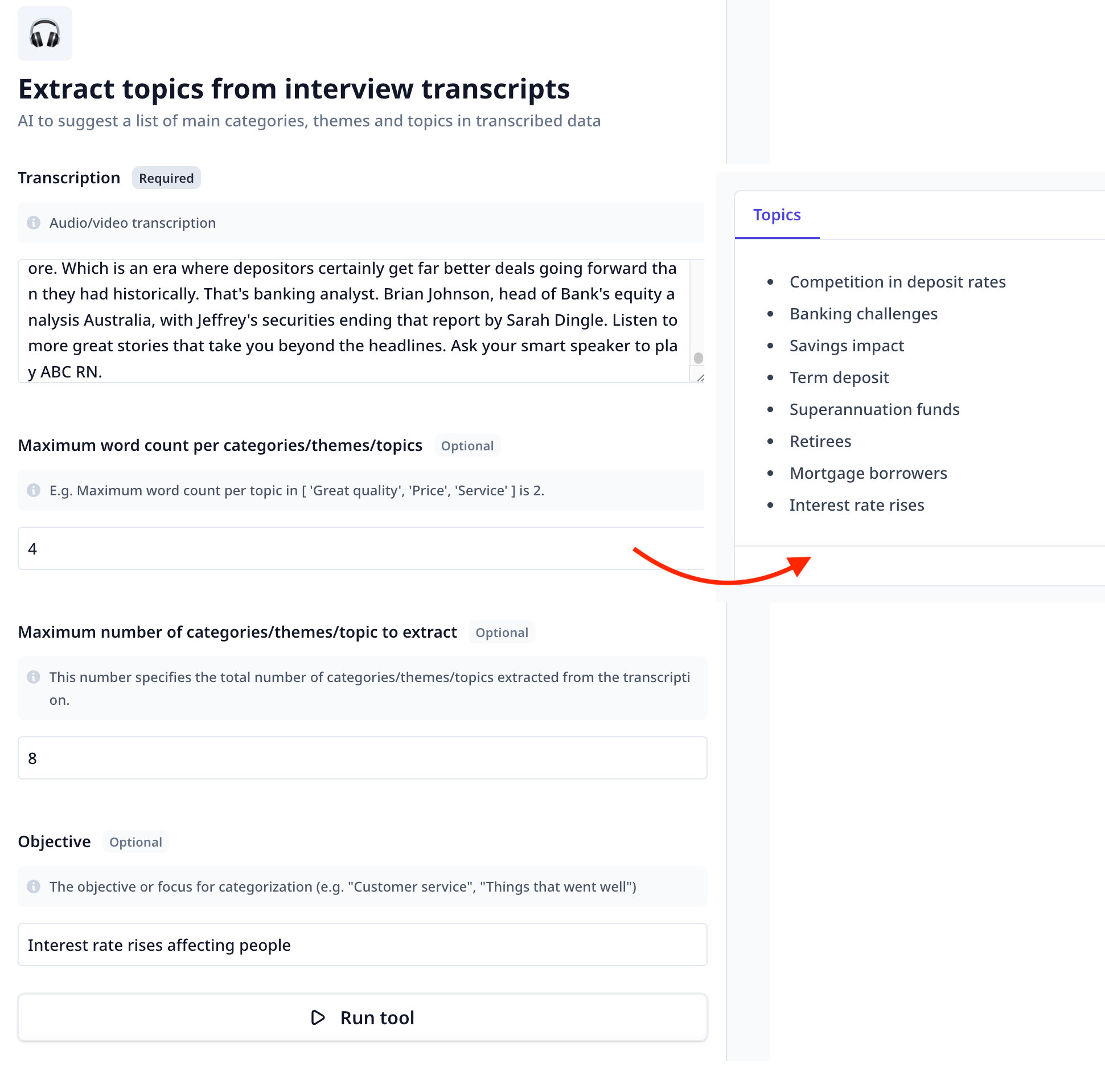Introduction
Welcome to the user guide for the “Extract Topics from Interview Transcripts” Tool! This Tool is designed to help you extract
main categories, themes, and topics from interview transcripts.
Whether you are a market researcher, journalist, or content creator, this Tool will assist you in analyzing and organizing the
key information from your interview data.
With its advanced AI capabilities and user-friendly interface, this Tool enables you to identify discussed themes and topics
within a few seconds.
Overview
The “Extract Topics from Interview Transcripts” Tool leverages cutting-edge artificial intelligence algorithms to analyze interview
transcripts and suggest a list of main categories, themes, and topics. It goes beyond keyword matching or word clouds and benefits
large language model and context identification to list key information discussed in the interviews.
By using this Tool, you can save time and effort in manually reviewing and organizing your interview data. With its powerful capabilities
and intuitive design, it is the perfect solution for extracting topics from interview transcripts.

Key Features
-
Transcription Analysis
You can easily copy your interview transcripts to the Tool or select the corresponding column in a data table when used in bulk run.
It analyzes the transcripts and identifies the main categories, themes, and topics discussed in the interviews.
-
Customizable Word Count:
You have the option to specify the maximum word count per topic. This allows you to control the level of detail and wordiness in the
extracted topics. For example, you can set a lower word count for more general topics (e.g. service) and a higher word count for more
details (e.g. very helpful service).
This feature ensures that the extracted topics align with your desired level of granularity.
-
Flexible Taxonomy Count:
You can specify the total number of categories, themes, or topics you want to extract from the interview transcripts. This allows you to
focus on the most important areas of discussion and avoid overwhelming amounts of information. This feature ensures that the extracted topics
are manageable and relevant to your analysis
-
Objective Specification
You have the flexibility to define the objective or focus for categorization. This could be the main research question, the purpose of the
interviews, or any specific area of interest. By specifying the objective, the Tool will provide you with topics that are more aligned with
your research goals.
Locate the Tool in the template page and click on Use template.
You can use the Tool as is or
clone it.
How to Use
Follow these steps to extract topics from your interview transcripts and gain valuable insights:
- Provide the transcript: Use copy-paste to provide the transcript into the Tool. Or when in a bulk-run, select
the corresponding column containing the transcription.
When an audio file is uploaded to Relevance AI, the platform automatically transcribes it. Results are
saved under “Text” column in the data table.
-
Specify Word Count: Set the maximum word count per topic. This allows you to control the level of detail in the extracted topics.
You can choose a lower word count for broader categories and a higher word count for more explanation over topics.
-
Specify Taxonomy Count: Define the total number of categories, themes, or topics you want to extract from the interview transcripts.
This ensures that the extracted topics are manageable and relevant to your analysis.
-
Specify Objective: Define the objective or focus for categorization. This could be the main research question, the purpose of the
interviews, or any specific area of interest. By specifying the objective, the Tool will provide you with topics that align with your
research goals.
-
Run the Tool: Once you have provided the transcripts, specified the word count, taxonomy count, and objective, click the “Run Tool”
button (on the App page) or use the run options on your data table (bulk/single run) to initiate the categorization process.
The Tool will analyze the transcripts and suggest a list of main categories, themes, and topics based on your specifications.
Tools and templates can be
-
tested on individually provided inputs:
-
set to fetch the data from a dataset and apply the analysis on the whole dataset:
-
View Results : The Tool will provide you with the extracted topics in an organized format. You can explore the results, review the
main categories, themes, and topics, and use this information to gain valuable insights from your interview data.
When working on multiple interview files, use this Tool in a bulk run (for all or some of the interviews).
Check the results and relying on your domain knowledge as well as the goal of analysis, create a finalized list of themes and topics.
The resulting list can be used in Utterance categorization
- View Results: The Tool will provide you with the extracted categories in a clear and organized format. You can explore the main categories,
themes, and topics identified in your data.
If you clone
a template, or make a Tool from scratch, you will have access to the
Build tab. Build is where one put together different components to build a Tool suitable for
their needs.

